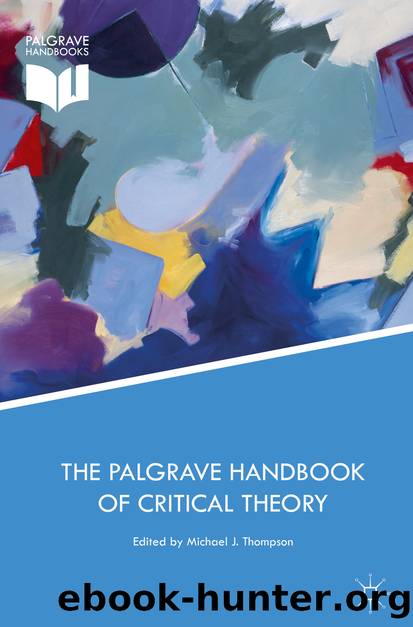The Palgrave Handbook of Critical Theory by Michael J. Thompson

Author:Michael J. Thompson
Language: eng
Format: epub
Publisher: Palgrave Macmillan US, New York
He argues here that the explicit, exaggerated and imagistic presentation of a latent and pervasive mode of social pathology serves as a kind of visceral immunization against this pathology. For example, the laughter that erupts in a Charlie Chaplin film responds to the same masochistic urge that culminates in the fascist rally, but at the same time reveals what is utterly ridiculous in such a collective incitement to violence. I propose that this notion of immunization reflects backward into Benjaminâs work from the 1920s to explain something crucial about the relation between critique, Denkbilder and mythology. One does not refute mythology merely by arguing against it, for the simple reason that it never allows itself to be formulated as an explicit belief. Rather, what is required in order to produce a relationship between mythology and truth is a kind of dialectical presentation that reveals the pervasiveness of mythology precisely in what is most modern, the regression within progress, the arbitrary violence within right, the religion within capitalism. At the same time, this inoculating relation between truth and mythology requires something like a monad in order for the presentation to achieve the proper combination of distance, clarity and comprehensiveness. In the just cited passage, the monadological aspect is provided by the analysis of certain aspects of early cinema. But I propose that this immunizing relationship between the artwork and social pathology also sheds insight on the relation between art criticism and mythology in Benjaminâs early thought. That is, critique does not translate the artwork into a theoretical framework and then argue against certain ideological positions. Rather, it examines the mode of experience entailed by artworks, and then it places this experiential monad in an immunological relation to the âmythicâ forms of experience that conceal and support the functioning of society in a juridical or economic sense.
In concluding, I believe that further study would be helpful to show how this concept of critique developed by Walter Benjamin would shape the development of the school of thought known as critical theory, especially through the philosopher Benjamin called his âonly true disciple,â Theodor Adorno (Eiland and Jennings 2014; 359). However I will suggest two points developed in this chapter that could serve as the basis for such a study.10 First, it is clear that Benjaminâs critique of mythology in modern life finds a much more general formulation in Adorno and Horkheimerâs Dialectic of Enlightenment. Even before this text taught us to posit a link between the rationalism of the enlightenment and the barbarity particular to contemporary life, Benjamin formulated a concept of mythology that is intertwined with the spread of capitalism and juridical, administrative rationality. Dialectic of Enlightenment posits Benjaminâs concept of mythology as a driver for a more global philosophy of history, but Benjaminâs thought remains valuable to the extent that it gives a far more nuanced formulation of mythology as a form of aesthetic and political experience. Second, more work needs to be done to read Adornoâs later masterpiece Aesthetic Theory as
Download
This site does not store any files on its server. We only index and link to content provided by other sites. Please contact the content providers to delete copyright contents if any and email us, we'll remove relevant links or contents immediately.
| Anthropology | Archaeology |
| Philosophy | Politics & Government |
| Social Sciences | Sociology |
| Women's Studies |
Born to Run: by Christopher McDougall(6895)
The Leavers by Lisa Ko(6806)
iGen by Jean M. Twenge(5163)
Sapiens by Yuval Noah Harari(5123)
The Kite Runner by Khaled Hosseini(4952)
Spare by Prince Harry The Duke of Sussex(4789)
Bullshit Jobs by David Graeber(3834)
Machine Learning at Scale with H2O by Gregory Keys | David Whiting(3630)
Livewired by David Eagleman(3534)
Never by Ken Follett(3528)
Goodbye Paradise(3446)
Fairy Tale by Stephen King(2950)
A Dictionary of Sociology by Unknown(2856)
Harry Potter 4 - Harry Potter and The Goblet of Fire by J.K.Rowling(2801)
The Social Psychology of Inequality by Unknown(2766)
The Club by A.L. Brooks(2747)
People of the Earth: An Introduction to World Prehistory by Dr. Brian Fagan & Nadia Durrani(2619)
0041152001443424520 .pdf by Unknown(2597)
Will by Will Smith(2580)
